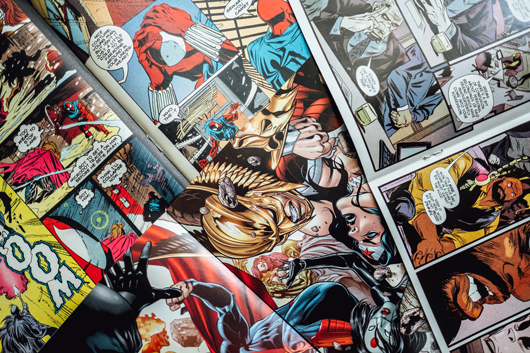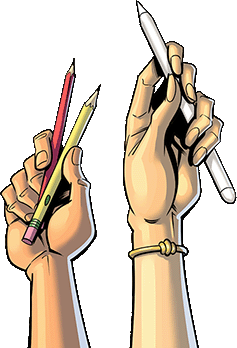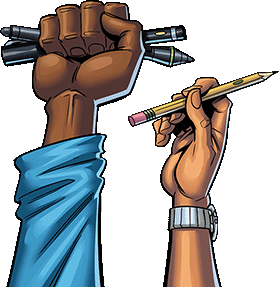Everything You Need to Know About Self-Publishing Comics
April 8, 2022
Self-publishing comic books is a fantastic adventure for enthusiasts who want to put their skills to the test as comic book creators. Self-publishing allows you to take control of your creative process. You get to decide on the story arc and depict your characters with creative freedom, allowing you to tell your own story without constraints.
Due to the rising interest in new indie comics and comic creators, there has never been a better time to engage with the indie comic book scene as a self-publisher. Learn everything you need to know about self-publishing comics, including the benefits of independent publishing and the publishing process.
The Benefits of Self-Publishing
Although writing and designing comic books and graphic novels is time-consuming work, it can be an extremely fulfilling endeavor. Self-publishing comics is a straightforward process made easy with the help of dedicated and experienced comics printers who provide professional services.
The benefits of self-publishing include faster publishing times, complete creative control, and a bigger return on your creative project.
Faster publishing times
The development of specialized digital templates, software, and printing techniques has made self-publishing more affordable than ever. Once you write and illustrate your book and prepare it for print, you can market and sell your comic in just a matter of days. You don’t have to wait for a traditional publishing house to decide when to release your project.
Full control
Self-publishing allows you to make all of the decisions regarding the design and content of your comic book. You can make changes when something isn’t working or keep in elements you don’t want to remove. This contrasts with traditional publishing approaches, which may force you to change your work to meet someone else’s criteria.
If you work with a major publisher, agents, editors, and a creative team will scour your work for elements that may not align with current trends. If they ask you to remove something, you may have to change your work and lose vital elements that make your story unique. By self-publishing, you retain control over your work, allowing you to stay true to your original vision.
Bigger return
One of the most desirable benefits of being a self-published comic book creator is keeping all the profits made from sales. Writers who go the traditional route receive a small percentage of the sales profits, typically around 15% for a paperback. As a self-published writer, all profits are yours once you print the books.
As a first-time comic writer, it’s challenging to make a name for yourself. You can cultivate recognition for your name and style by self-publishing a comic. Creating a reputation builds traction and helps you sell more of your books and develop a fanbase.
The Self-Publishing Process: Writing and Planning
If you are new to the writing process, it may be wise to plan a short series or even a single-volume graphic novel. Creating comics can be time-consuming, and even a short series may take much more time than you expect. Getting accustomed to the process can help you make a higher-quality book for readers.
It is important not to overextend yourself, especially if this is your first time creating self-published comics. Overcommitting to a long and complex series can leave you exhausted or burnt out. Instead, opt for a short series and consider expanding it with additional issues or volumes as your audience grows.
Consider teaming up with a writer, comic book artist, or other indie creators to work on the story. If your art skills aren’t quite up to scratch for the story you want to tell, working with an illustrator may be the key to creating a comic that’s engaging, clear, and fun to read. Many comic book authors work with creative partners throughout their careers to see their projects to completion.
Designing Your Comic Book
Once you’ve written and sketched out a comic, you need to make sure it fits your printer’s design templates and specifications. If you choose an independent printer like Comix Well Spring, you’ll have to make important decisions regarding size, paper type, binding type, and color.
To choose the right size for your comic book, consider the industry standards. The industry-standard size for a comic book measures 6.625” x 10.25”; however, some books come in sizes as small as 5.5” x 7.75” to books as large as 9” x 12”. Regardless of book size, all text and essential visuals need to remain at least 0.125” inside the margin to ensure nothing gets cut off during printing.
You can print in full color or opt for black and white. Color printing is more expensive but generally makes a more significant impression on readers. You can also choose a full-color cover with black and white interior pages.
At Comix Well Spring, our standard comics use uncoated interior paper with a cover paper printed on a gloss cover card stock. We also offer a range of additional paper types to suit your needs. You can also include a foil, laminated, or extra-high gloss (UV-resistant) cover to minimize color fade.
There are several choices available for binding. Square (perfect) binding is created using binding glue and is ideal for larger comic books. Perfect bound books are durable with a professional look but are generally more expensive to create. Saddle stitch (staple) is a more cost-efficient binding option for producing a comic book. This method uses small wire staples and is suitable for up to 64-page books.
The Printing Process
Once the designing phase is complete, it is time to ensure that your artwork fits the design template you have chosen. This involves making sure your images fit the dimensions of the book size you selected and making sure you are happy with your book cover.
Plan the template before you put hard work into inking and lettering, as you may have to alter illustrations to fit the page. When you are satisfied with the template and have sent us a PDF file of your comic book, Comix Well Spring offers you the choice of receiving a physical or digital proof to proofread and double-check for printing errors. This is an essential part of the process as it is the final time to check the work before printing.
Ordering Books
If you’re new to self-publishing and haven't built up a name for yourself just yet, you may want to order smaller print runs instead of spending too much money upfront. Fortunately, Comix Well Spring offers print-on-demand services with a minimum order quantity of 25 for saddle stitched stapled comics and square-bound paperbacks. This allows indie artists to keep production costs low while building up their readership.
Once you have placed your printing order, it usually takes us 14 days to print and ship your new comic books. Shipping times may also vary depending on the area of the country you live in, so it’s important to leave enough time for both production and shipping. We offer rush production and shipping options to get your books on time for comic book conventions and sell in comic book stores.

Marketing and Promoting Your Self-Published Comic Book
Marketing a comic book isn’t as simple as setting up social media accounts and paying for ads. Indie comics are a niche market, and you’ll need to be genuinely active in the broader comic community to get noticed by comic book fans.
Visiting comic book conventions is a great way to gain exposure. Setting up a table at a convention allows comic books to interact directly with you and your work which is a great way to gain new readers. You could also share a table with other indie creators to team up and get some attention. Make sure you're visible with a retractable banner stand that showcases your art and comic book title.
Even established indie authors may struggle to turn a profit at first, so don’t invest too much money in marketing from the beginning. Instead, rely on word-of-mouth and build up your following organically. You can even connect and collaborate with other artists and writers to reach a broader audience. Forums like the Comic Book Resources Community can help you engage with other comic book fans and potential new readers.
The Self-Publishing Journey
Being an indie creator and designing your first comic book is a true passion project, especially in the beginning for comic artists without significant name backing. Indie creators may struggle to get noticed at first, but that doesn’t mean you should give up. The fun of indie publishing often comes from developing a relationship with readers who are passionate about comics.
At Comix Well Spring, we work hard to provide a fast and straightforward system for getting your comics printed. You can have your comic book within two weeks when you use Comix Well Spring to upload digital files, select your design customization options, and sign off on your proofs.
Our low minimum order quantity makes us a leader in indie comic printing, whether you’re new to self-publishing or are looking for a new publisher for your existing projects.
If self-publishing a comic book is something you’ve always dreamed about doing, call us today at (734) 927-0044 to find out how to get started.


